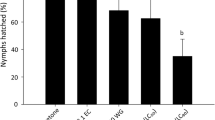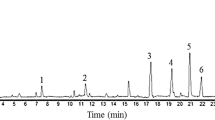Abstract
Among tropical plant families, members of Annonaceae have great potential as a source of biopesticides. To develop an alternative tool for control of Helicoverpa armigera, efficacy of ethanolic extracts from seeds of five species belonging to the genus Annona (A. montana Macfad., A. mucosa Jacq., A. muricata L., A. reticulata L. and A. sylvatica A. St.-Hil.) and an acetogenin-based commercial bioinsecticide (Anosom® 1 EC, 10,000 ppm of annonin as the main active ingredient) were evaluated in a dietary exposure bioassays. In an initial screening, an ethanolic extract from A. mucosa seeds (LC50 = 1479 ppm) and Anosom® 1 EC (LC50 = 1151 ppm) were the most promising treatments. In addition to acute toxicity, pronounced inhibition of H. armigera larval growth was observed in both treatments. Using chromatographic techniques, bioguided fractionations were conducted and the acetogenin bis-tetrahydrofuran rolliniastatin-1 was isolated as the primary compound from the most active fractions of A. mucosa. At a concentration of 41.55 ppm, rolliniastatin-1 caused total mortality of H. armigera larvae after the fourth day of exposure. In greenhouse trials, extract of A. mucosa (as an emulsifiable concentrate formulation) and the botanical insecticide based on extract of Annona squamosa L. (Anosom® 1 EC), both at LC90 values previously estimated, were compared with a diamide-based commercial insecticide (flubendiamide 480 SC) for mortality after 168 h of exposure to larvae on tomato plants; all treatments caused high larval mortality (>90%). Thus, the results of this study indicate that the derivatives of Annonaceae are a useful alternative for the integrated management of H. armigera.

Similar content being viewed by others
References
Aheer GM, Shah Z, Saeed M (2009) Seasonal history and biology of cotton mealy bug, Phenacoccus solenopsis Tinsley. J Agric Res 47:4
Alali FQ, Liu XX, McLaughlin JL (1999) Annonaceous acetogenins: recent progress. J Nat Prod 62:504–540. doi:10.1021/np980406d
Ansante TF, Ribeiro LP, Bicalho KU, Fernandes JB, Silva MFGF, Vieira PC, Vendramim JD (2015) Secondary metabolites from Neotropical Annonaceae: screening, bioguided fractionation, and toxicity to Spodoptera frugiperda (JE Smith)(Lepidoptera: Noctuidae). Ind Crops Prod 74:969–976. doi:10.1016/j.indcrop.2015.05.058
Baldin ELL, Aguiar GP, Fanela TL, Soares MC, Groppo M, Crotti AE (2015) Bioactivity of Pelargonium graveolens essential oil and related monoterpenoids against sweet potato whitefly, Bemisia tabaci biotype B. J Pest Sci 88:191–199. doi:10.1007/s10340-014-0580-8
Blessing LT, Colom OA, Popich S, Neske A, Bardón A (2010) Antifeedant and toxic effects of acetogenins from Annona montana on Spodoptera frugiperda. J Pest Sci 83:307–310. doi:10.1007/s10340-010-0299-0
Blessing LD, Ramos J, Diaz S, Ben AA, Bardón A, Brovetto M, Neske A (2012) Insecticidal properties of annonaceous acetogenins and their analogues. Interaction with lipid membranes. Nat Prod Commun 7:1215–1218. doi:10.1021/bi972348l
Bueno AF, Sosa-Gómez DR (2014) The old world bollworm in the Neotropical region: the experience of Brazilian growers with Helicoverpa armigera. Outlook Pest Manag 25:261–264. doi:10.1564/v25_aug_04
Bueno RCOF, Yamamoto PT, Carvalho MM, Bueno NM (2014) Occurrence of Helicoverpa armigera (Hübner, 1808) on citrus in the state of Sao Paulo, Brazil. Rev Bras Frutic 36:520–523. doi:10.1590/0100-2945-357/13
Castillo-Sánchez LE, Jiménez JJ, Delgado MA (2010) Secondary metabolites of the Annonaceae, Solanaceae and Meliaceae families used as biological control of insects. Trop Subtrop Agric J 12:445–462
Chatrou LW, Rainer H, Maas PJM (2004) Annonaceae (Soursop family). In: Smith N (ed) Flowering plants of the neotropics. Botanical Garden, New York, pp 18–20
Cloyd R (2004) Natural indeed: are natural insecticide safer and better than conventional insecticide? Ill Pestic Rev 17:1–3
Colom OÁ, Neske A, Popich S, Bardón A (2007) Toxic effects of annonaceous acetogenins from Annona cherimolia (Magnoliales: Annonaceae) on Spodoptera frugiperda (Lepidoptera: Noctuidae). J Pest Sci 80:63–67. doi:10.1007/s10340-006-0149-2
Czepak C, Albernaz KC, Vivan LM, Guimarães HO, Carvalhais T (2013) Primeiro registro de ocorrência de Helicoverpa armigera (Hübner) (Lepidoptera: Noctuidae) no Brasil. Pesqui Agropecu Trop 43:110–113. doi:10.1590/S1983-40632013000100015
Demétrio CGB, Hinde J (1997) Half-normal plots and overdispersion. Glim Newsl 27:19–26
Finney DJ (1971) Probit analysis. Cambridge University Press, Cambridge
Gonçalves GLP, Ribeiro LP, Gimenes L, Vieira PC, Silva MFGF, Forim MR, Vendramim JD (2015) Lethal and sublethal toxicities of Annona sylvatica (Magnoliales: Annonaceae) extracts to Zabrotes subfasciatus (Coleoptera: Chrysomelidae: Bruchinae). Fla Entomol 98:921–928. doi:10.1653/024.098.0317
Greene GL, Leppla NC, Dickerson WA (1976) Velvetbean caterpillar: a rearing procedure and artificial medium. J Econ Entomol. doi:10.1093/jee/69.4.487487-488
He H, Zeng L, Ye Q, Shi G, Oberlies N, Zhao G, Njoku C, Mclaughlin J (1997) Comparative SAR evaluations of annonaceous acetogenins for pesticidal acitivity. Pestic Sci 49:372–378. doi:10.1002/(SICI)10969063(199704)49:4<372:AID-PS543>3.0.CO;2-K
Hinde J, Demétrio CGB (1998) Overdispersion: models and estimation. Comput Stat Data Anal 27:151–170. doi:10.1016/S0167-9473(98)00007-3
Isman MB (2000) Plant essential oils for pest and disease management. Crop Prot 19:603–608. doi:10.1016/S0261-2194(00)00079-X
Isman MB (2006) Botanical insecticides, deterrents, and repellents in modern agriculture and an increasingly regulated world. Annu Rev Entomol 51:45–66. doi:10.1146/annurev.ento.51.110104.151146
Isman MB, Grieneisen ML (2014) Botanical insecticide research: many publications, limited useful data. Trends Plant Sci 19:140–145. doi:10.1016/j.tplants.2013.11.005
Isman MB, Seffrin R (2014) Natural insecticides from the Annonaceae: a unique example for developing biopesticides. In: D Singh (ed) Advances in plant biopesticides. Springer, New Delhi, pp 21–33. doi: 10.1007/978-81.322-2006-0_2
Jah RK, Chi H, Tang LC (2012) A comparison of artificial diet and hybrid sweet corn for the rearing of Helicoverpa armigera (Hübner) (Lepidoptera: Noctuidae) based on life table characteristics. Environ Entomol 41:30–39. doi:10.1603/EN11206
Jouben N, Agnolet S, Lorenz S, Schöne SE, Ellinger R, Schneider B, Heckel DG (2012) Resistance of Australian Helicoverpa armigera to fenvalerate is due to the chimeric P450 enzyme CYP337B3. Proc Nat Acad Sci U.S.A. 109:15206–15211. doi:10.1073/pnas.1202047109
Kao SS (1995) Mass rearing of insects. Bulletin of Taiwan Agricultural Chemicals and Toxic Substances Research Institute (TACTRI) 37:1–8
Lammers JW, Macleod A (2007) Report of a pest risk analysis: Helicoverpa armigera (Hübner, 1808). http://www.fera.defra.gov.uk/plants/ plantHealth/pestsDiseases/documents/helicoverpa.pdf. Accessed on 5 Oct 2014
Leatemia JA, Isman MB (2004) Efficacy of crude seed extracts of Annona squamosa against diamondback moth, Plutella xylostella L. in the greenhouse. Int J Pest Manage 50:129–133. doi:10.1080/096708704100001691821
Lewis MA, Arnason JT, Philogene BJR, Rupprecht JK, Mclaughlin JL (1993) Inhibition of respiration at site I by asimicin, an insecticidal acetogenin of the pawpaw, Asimina triloba (Annonaceae). Pestic Biochem Physiol 45:15–23. doi:10.1006/pest.1993.1003
Murúa MG, Scalora FS, Navarro FR, Cazado LE, Casmuz A, Villagrán ME, Lobos E, Gastaminza G (2014) First record of Helicoverpa armigera (Lepidoptera: Noctuidae) in Argentina. Fla Entomol 97:854–856. doi:10.1653/024.097.0279
Nelder JA, Wedderburn RWM (1972) Generalized linear models. J R Stat Sci 135:370–384. doi:10.2307/2344614
Ocampo D, Ocampo R (2006) Bioactividad de la familia Annonaceae. Rev Univ Caldas 1:135–155
R Development Core Team (2012) R: a language and environment for statistical computing. R foundation for statistical computing, Vienna, pp 73–80
Ribeiro LP, Vendramim JD, Bicalho KU, Andrade MS, Fernandes JB, Moral RA, Demétrio CGB (2013) Annona mucosa Jacq. (Annonaceae): a promising source of bioactive compounds against Sitophilus zeamais Mots. (Coleoptera: Curculionidae). J Stored Prod Res 55:6–14. doi:10.1016/j.jspr.2013.06.001
Ribeiro LP, Akhtar Y, Vendramim JD, Isman MB (2014a) Comparative bioactivity of selected seed extracts from Brazilian Annona species and an acetogenin-based commercial bioinsecticide against Trichoplusia ni and Myzus persicae. Crop Prot 62:100–106. doi:10.1016/j.cropro.2014.04.013
Ribeiro LP, Vendramim JD, Andrade MS, Bicalho KU, Silva MFGF, Vieira PC, Fernandes JB (2014b) Tropical plant extracts as sources of grain-protectant compounds against Sitophilus zeamais Motschulsky (Coleoptera: Curculionidae). Neotrop Entomol 43:470–482. doi:10.1007/s13744-014-0233-x
Ribeiro LP, Zanardi OZ, Vendramim JD, Yamamoto PT (2014c) Comparative toxicity of an acetogenin-based extract and commercial pesticides against citrus red mite. Exp Appl Acarol 64:87–98. doi:10.1007/s10493-014-9810-2
Ribeiro LP, Santos MS, Gonçalves GLP, Vendramim JD (2015) Toxicity of an acetogenin-based bioinsecticide against Diaphorina citri (Hemiptera: Liviidae) and its parasitoid Tamarixia radiata (Hymenoptera: Eulophidae). Fla Entomol 98:835–842. doi:10.1653/024.098.0304
SAS Institute (2011) Statistical analysis system: getting started with the SAS learning. Version 9.2. NC: SAS Institute
Specht A, Gomez DR, Paula-Moraes SV, Yano SA (2013) Morphological and molecular identification of Helicoverpa armigera (Lepidoptera: Noctuidae) and expansion of its occurrence record in Brazil. Pesqui Agropecu Bras 48:689–692. doi:10.1590/S0100-204X2013000600015
Tak JH, Jovel E, Isman MB (2016) Contact, fumigant, and cytotoxic activities of thyme and lemongrass essential oils against larvae and an ovarian cell line of the cabbage looper, Trichoplusia ni. J Pest Sci 89:183–193. doi:10.1007/s10340-015-0655-1
Talekar NS, Opena RT, Hanson P (2006) Helicoverpa armigera management: a review of AVRDC’s research on host plant resistance in tomato. Crop Prot 25:461–467. doi:10.1016/j.cropro.2005.07.011
Throne JE, Weaver DK, Chew VB, James E (1995) Probit analysis of correlated data: multiple observations over time at one concentration. J Econ Entomol 88:1510–1512. doi:10.1093/jee/88.5.1510
Tolosa D, Hidalgo JR, Sal PE, Popich S, Bardón A, Neske A (2014) Insecticidal effects of the Annonaceous acetogenin squamocin and the acetogenin fraction of seeds of Rollinia occidentalis on soybean and corn pests. J Agric Food Chem 3:156–160. doi:10.1007/s10340-006-0149-2
Trindade RCP, Luna JS, Lima MRF, Silva PP, Santana AEG (2006) Actividad larvicida y variacion estacional del extracto de Annona muricata en Plutella xylostella (Lepidoptera: Plutellidae). Rev Colomb Entomol 3:223–228
Venette RC, Davis EE, Zaspel Z, Heisler H, Larson M (2003) Mini risk assessment, old world bollworm, Helicoverpa armigera (Hübner) (Lepidoptera: Noctuidae). US department of agriculture, animal and plant health inspection service. http://www.aphis.usda.gov/plant_health/plant_pest_info/pest_detection/do wnloads/pra/harmigerapra.pdf. Accessed 8 Apr 2013
Yang Y, Li Y, Wu Y (2013) Current status of insecticide resistance in Helicoverpa armigera after 15 years of Bt cotton planting in China. J Econ Entomol 106:375–381. doi:10.1603/EC12286
Zanardi OZ, Ribeiro LP, Ansante TF, Santos MS, Bordini GP, Yamamoto PT, Vendramim JD (2015) Bioactivity of a matrine-based biopesticide against four pest species of agricultural importance. Crop Prot 67:160–167. doi:10.1016/j.cropro.2014.10.010
Zhang H, Yin W, Zhao J, Jin L, Yang Y, Wu S, Tabashnik BE, Wu Y (2011) Early warning of cotton bollworm resistance associated with intensive planting of Bt cotton in China. PLoS ONE 6:22874. doi:10.1371/journal.pone.0022874
Acknowledgements
Funding for research was provided by Coordination for the Improvement of Higher Education Personnel.
Author information
Authors and Affiliations
Corresponding author
Ethics declarations
Conflict of interest
All authors declare that they have no conflict of interest.
Ethical approval
This article does not contain any studies with human or animal performed by any of the authors.
Additional information
Communicated by M.B. Isman.
Rights and permissions
About this article
Cite this article
Souza, C.M., Baldin, E.L.L., Ribeiro, L.P. et al. Lethal and growth inhibitory activities of Neotropical Annonaceae-derived extracts, commercial formulation, and an isolated acetogenin against Helicoverpa armigera . J Pest Sci 90, 701–709 (2017). https://doi.org/10.1007/s10340-016-0817-9
Received:
Revised:
Accepted:
Published:
Issue Date:
DOI: https://doi.org/10.1007/s10340-016-0817-9




